Scientists propose ‘umbrella’ to block sunlight and reduce global warming
MANILA, Philippines – Have you ever had such an outrageous idea and thought: “This is so crazy it just might work?”
It seems many scientists have been having such a mindset lately as a team from Israel proposed blocking sunlight to cool the Earth.
Believe it or not, they claim it could cool our planet down by 2.7°F or roughly -16.2°C.
Looking at recent climate data, you’ll realize why many experts consider such drastic measures.
In 2023, I reported how average global temperatures rose by more than 2°C for the first time. Soon, the world might become too hot to support human life.
If our ongoing climate efforts aren’t working, then perhaps we should consider other proposals for our survival.
How can we put an umbrella over the Earth?
Check out @TechnionLive Professor Yoram Rozen in @nytimes: “We at the Technion are not going to save the planet, but we’re going to show that it can be done.” He discussed Cool Earth, an @IsraelSpace project to combat climate change with @caraNYT: https://t.co/pEyE4SPxw6 pic.twitter.com/lBauLoAgdm
— American Technion Society (@TechnionUSA) February 2, 2024
Technion-Israel Institute of Technology wants to deploy a shade or “sail” nine million miles from Earth.
Then, it would move through space by opening and closing its shading layer.
“We at the Technion are not going to save the planet,” project leader Yoram Rozen said. “But we’re going to show that it can be done.”
He and his team call their initiative Cool Earth. It would require a “giant umbrella” of roughly one million square miles, approximately the size of Argentina.
Of course, launching such a structure from the Earth to space is almost impossible.
That is why Rozen and his colleagues propose sending smaller shades that will work together.
They have not disclosed the material for this space umbrella, but they will ensure a flexible design that will take them to the first Lagrange point (L1).
The Daily Mail says L1 is a “position in space where the gravitational forces of a two-body system like the Sun and the Earth produce enhanced regions of attraction and repulsion.”
“[The demonstrator satellite] will perform a variable movement towards the sun and back to the Earth by controlling the shading sail,” the team said.
You may also like: OpenAI leaders propose AI regulations
“In this way, the satellite will be able to maintain its position in space for a significant duration and without dependence on complex propulsion systems.”
“We can show the world, ‘Look, there is a working solution. Take it. Increase it to the necessary size,” Rozen told The New York Times. However, critics say the umbrella is a waste of time.
Susanne Baur, a doctoral candidate at the European Center for Research and Advanced Training in Scientific Computation in France, told the NYT that the shades would be “astronomically expensive and could not be implemented in time.”
Are there other ways to cover the Earth?

Peter Irvine, an Earth Science Lecturer at the University College London (UCL), is also concerned about global warming.
In a previous Inquirer Tech article, he suggested blocking sunlight by releasing particles in the sky.
The Earth Science expert cited powerful volcanic eruptions from the Philippines’ Mt. Pinatubo and Indonesia’s Mt. Tambora as an example of his unusual solution.
He said these phenomena spread microscopic particles in the upper atmosphere the last several years.
Similarly, we could copy this effect by deploying jets to release reflective particles into the upper atmosphere.
He cited environmental research from IOPScience as evidence.
Reducing sunlight wouldn’t perfectly undo climate change. We could, however place an even cooling effect worldwide by choosing where we release particles.
Irvine says this approach could significantly reduce climate risks. Otherwise, they would likely worsen over time.
For example, he says several species are migrating to the Earth’s poles for lower temperatures.
Global temperatures are also breaching the human body’s threshold, risking the lives of outdoor workers. Moreover, warmer air draws more moisture from the soil during dry spells and dumps more rain.
You may also like: Elevate Your Writing with ChatGPT
In other words, climate change is worsening droughts and floods worldwide. Irvine believes reducing sunlight could offset this effect.
He also believes blocking sunlight could keep our frigid regions frozen. That could prevent rising sea levels and the leaking of methane from permafrost.
Still, the UCL expert admits his proposal won’t prevent greenhouse gas buildup. It will not stop people from releasing carbon dioxide and other pollutants.
Do you have other ideas?
Scientists see how quickly and drastically our planet is warming.
That is why many are proposing unexpected ideas like covering our planet with particles or a giant umbrella.
We’ve been implementing more sensible ideas like holding global climate conferences. Regardless, the planet continues to become too hot for humans.
If we won’t scatter atmospheric particles or cover our planet with a giant layer, what should we do? Check the latest digital tips and trends at Inquirer Tech.